Information Systems and Organizations: SCL Report Analysis
VerifiedAdded on 2022/12/22
|22
|5612
|1
Report
AI Summary
This report provides a comprehensive analysis of the information systems utilized by Smart Constructions Limited (SCL), a company specializing in smart home construction. It delves into various aspects including IT provisioning, the implementation of enterprise systems, and the necessity of Application Portfolio Management (APM). The report explores the significance of IT portfolio management, detailing the merits and demerits of purchasing versus leasing information systems. Furthermore, it examines the role and benefits of Decision Support Systems (DSS) for SCL, including different types of DSS and their advantages. The report also addresses the use of technology in smart homes, the concept of Outsourcing Relationship Management (ORM) systems, and the broader societal and environmental impact of smart home technology. The analysis provides insights into how SCL can leverage information systems for strategic advantage and operational efficiency.
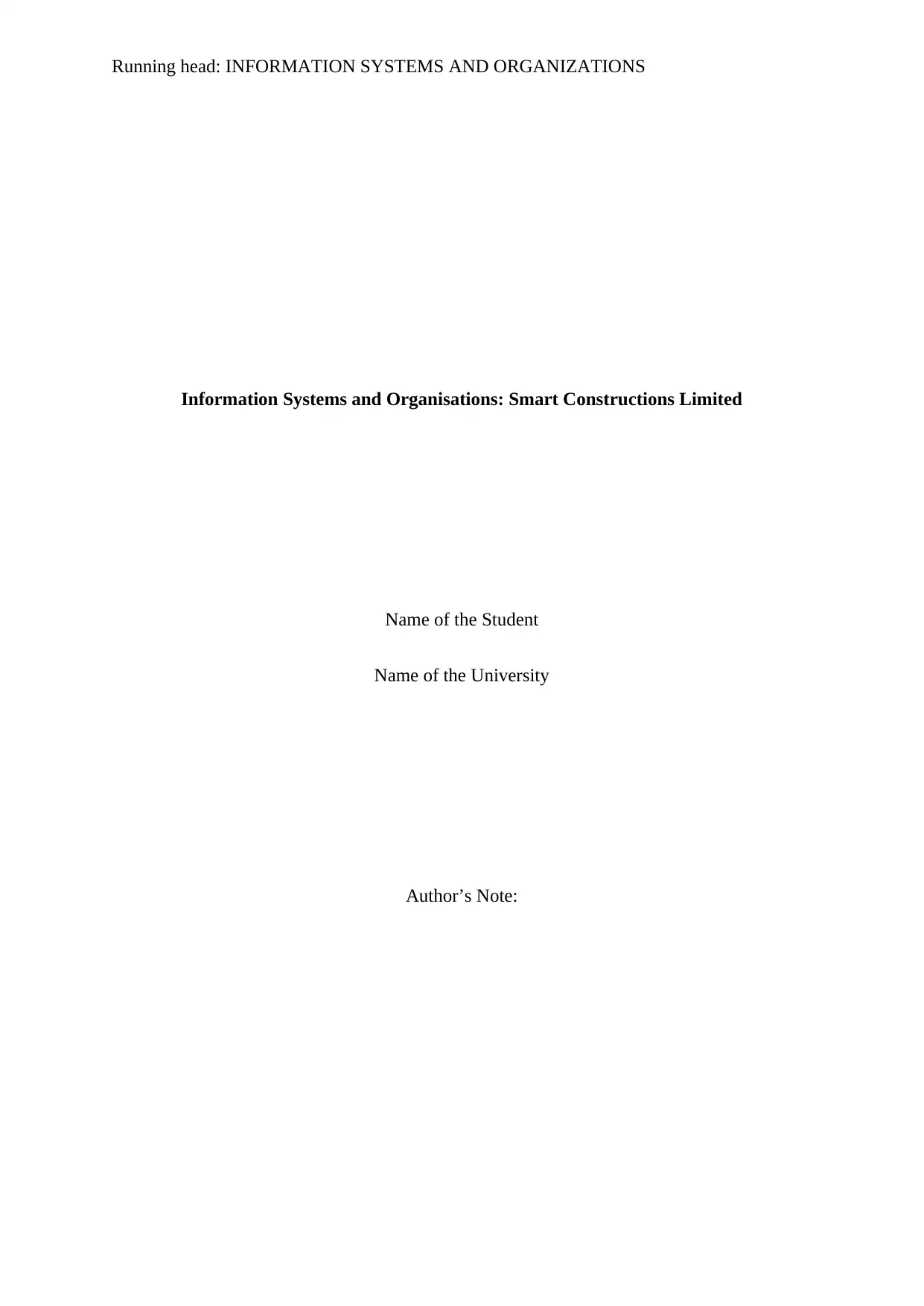
Running head: INFORMATION SYSTEMS AND ORGANIZATIONS
Information Systems and Organisations: Smart Constructions Limited
Name of the Student
Name of the University
Author’s Note:
Information Systems and Organisations: Smart Constructions Limited
Name of the Student
Name of the University
Author’s Note:
Paraphrase This Document
Need a fresh take? Get an instant paraphrase of this document with our AI Paraphraser
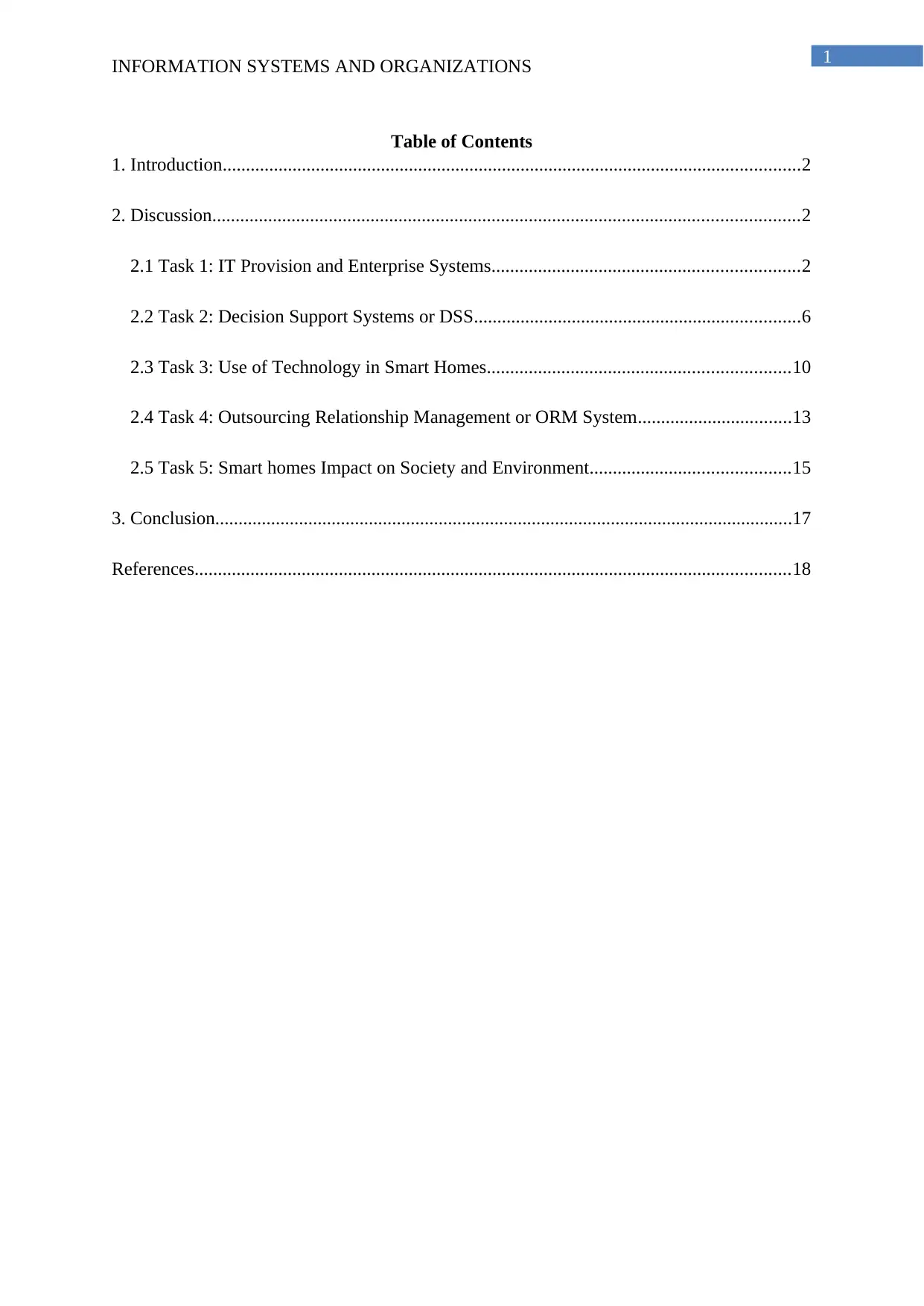
1
INFORMATION SYSTEMS AND ORGANIZATIONS
Table of Contents
1. Introduction............................................................................................................................2
2. Discussion..............................................................................................................................2
2.1 Task 1: IT Provision and Enterprise Systems..................................................................2
2.2 Task 2: Decision Support Systems or DSS......................................................................6
2.3 Task 3: Use of Technology in Smart Homes.................................................................10
2.4 Task 4: Outsourcing Relationship Management or ORM System.................................13
2.5 Task 5: Smart homes Impact on Society and Environment...........................................15
3. Conclusion............................................................................................................................17
References................................................................................................................................18
INFORMATION SYSTEMS AND ORGANIZATIONS
Table of Contents
1. Introduction............................................................................................................................2
2. Discussion..............................................................................................................................2
2.1 Task 1: IT Provision and Enterprise Systems..................................................................2
2.2 Task 2: Decision Support Systems or DSS......................................................................6
2.3 Task 3: Use of Technology in Smart Homes.................................................................10
2.4 Task 4: Outsourcing Relationship Management or ORM System.................................13
2.5 Task 5: Smart homes Impact on Society and Environment...........................................15
3. Conclusion............................................................................................................................17
References................................................................................................................................18
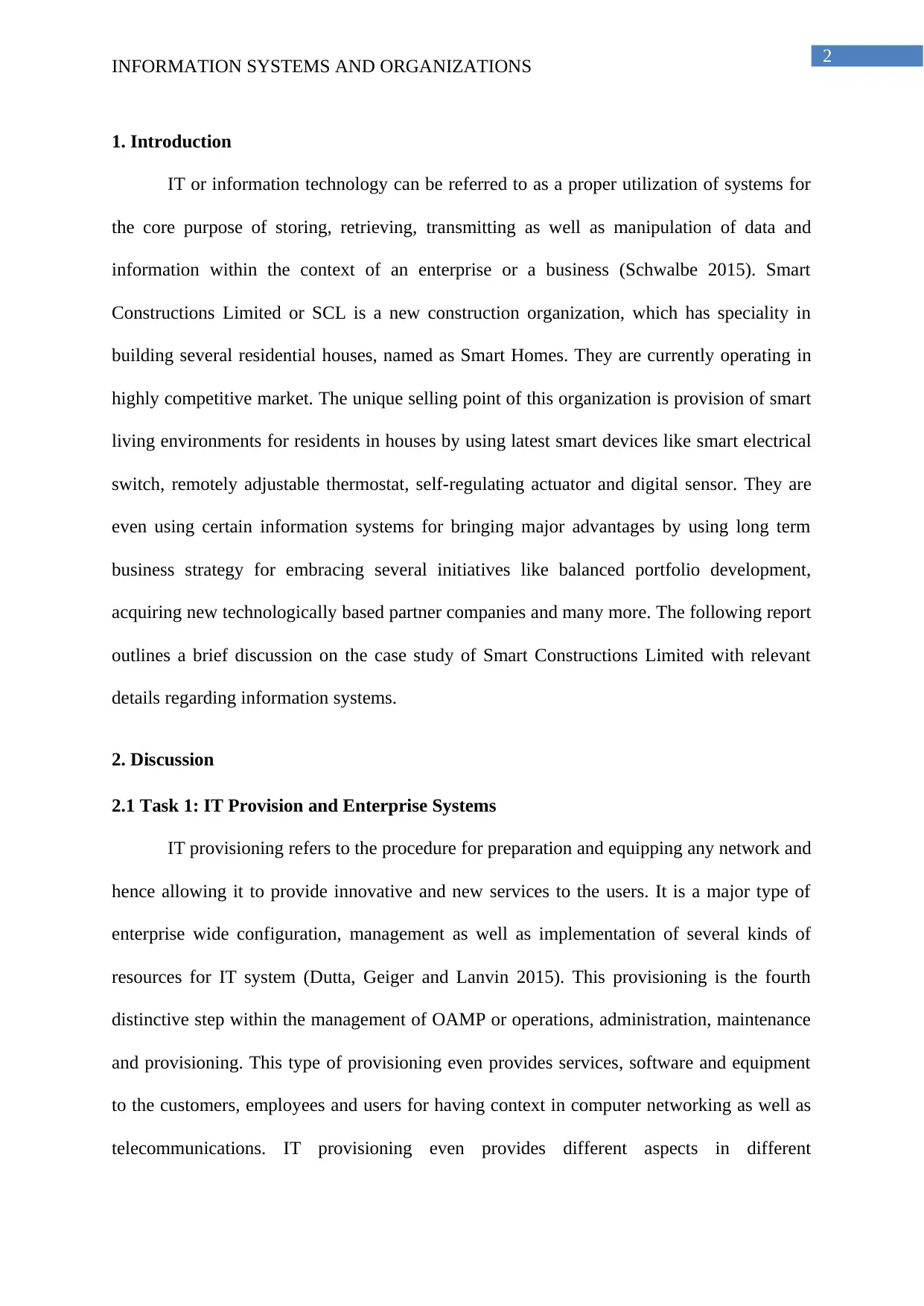
2
INFORMATION SYSTEMS AND ORGANIZATIONS
1. Introduction
IT or information technology can be referred to as a proper utilization of systems for
the core purpose of storing, retrieving, transmitting as well as manipulation of data and
information within the context of an enterprise or a business (Schwalbe 2015). Smart
Constructions Limited or SCL is a new construction organization, which has speciality in
building several residential houses, named as Smart Homes. They are currently operating in
highly competitive market. The unique selling point of this organization is provision of smart
living environments for residents in houses by using latest smart devices like smart electrical
switch, remotely adjustable thermostat, self-regulating actuator and digital sensor. They are
even using certain information systems for bringing major advantages by using long term
business strategy for embracing several initiatives like balanced portfolio development,
acquiring new technologically based partner companies and many more. The following report
outlines a brief discussion on the case study of Smart Constructions Limited with relevant
details regarding information systems.
2. Discussion
2.1 Task 1: IT Provision and Enterprise Systems
IT provisioning refers to the procedure for preparation and equipping any network and
hence allowing it to provide innovative and new services to the users. It is a major type of
enterprise wide configuration, management as well as implementation of several kinds of
resources for IT system (Dutta, Geiger and Lanvin 2015). This provisioning is the fourth
distinctive step within the management of OAMP or operations, administration, maintenance
and provisioning. This type of provisioning even provides services, software and equipment
to the customers, employees and users for having context in computer networking as well as
telecommunications. IT provisioning even provides different aspects in different
INFORMATION SYSTEMS AND ORGANIZATIONS
1. Introduction
IT or information technology can be referred to as a proper utilization of systems for
the core purpose of storing, retrieving, transmitting as well as manipulation of data and
information within the context of an enterprise or a business (Schwalbe 2015). Smart
Constructions Limited or SCL is a new construction organization, which has speciality in
building several residential houses, named as Smart Homes. They are currently operating in
highly competitive market. The unique selling point of this organization is provision of smart
living environments for residents in houses by using latest smart devices like smart electrical
switch, remotely adjustable thermostat, self-regulating actuator and digital sensor. They are
even using certain information systems for bringing major advantages by using long term
business strategy for embracing several initiatives like balanced portfolio development,
acquiring new technologically based partner companies and many more. The following report
outlines a brief discussion on the case study of Smart Constructions Limited with relevant
details regarding information systems.
2. Discussion
2.1 Task 1: IT Provision and Enterprise Systems
IT provisioning refers to the procedure for preparation and equipping any network and
hence allowing it to provide innovative and new services to the users. It is a major type of
enterprise wide configuration, management as well as implementation of several kinds of
resources for IT system (Dutta, Geiger and Lanvin 2015). This provisioning is the fourth
distinctive step within the management of OAMP or operations, administration, maintenance
and provisioning. This type of provisioning even provides services, software and equipment
to the customers, employees and users for having context in computer networking as well as
telecommunications. IT provisioning even provides different aspects in different
⊘ This is a preview!⊘
Do you want full access?
Subscribe today to unlock all pages.

Trusted by 1+ million students worldwide
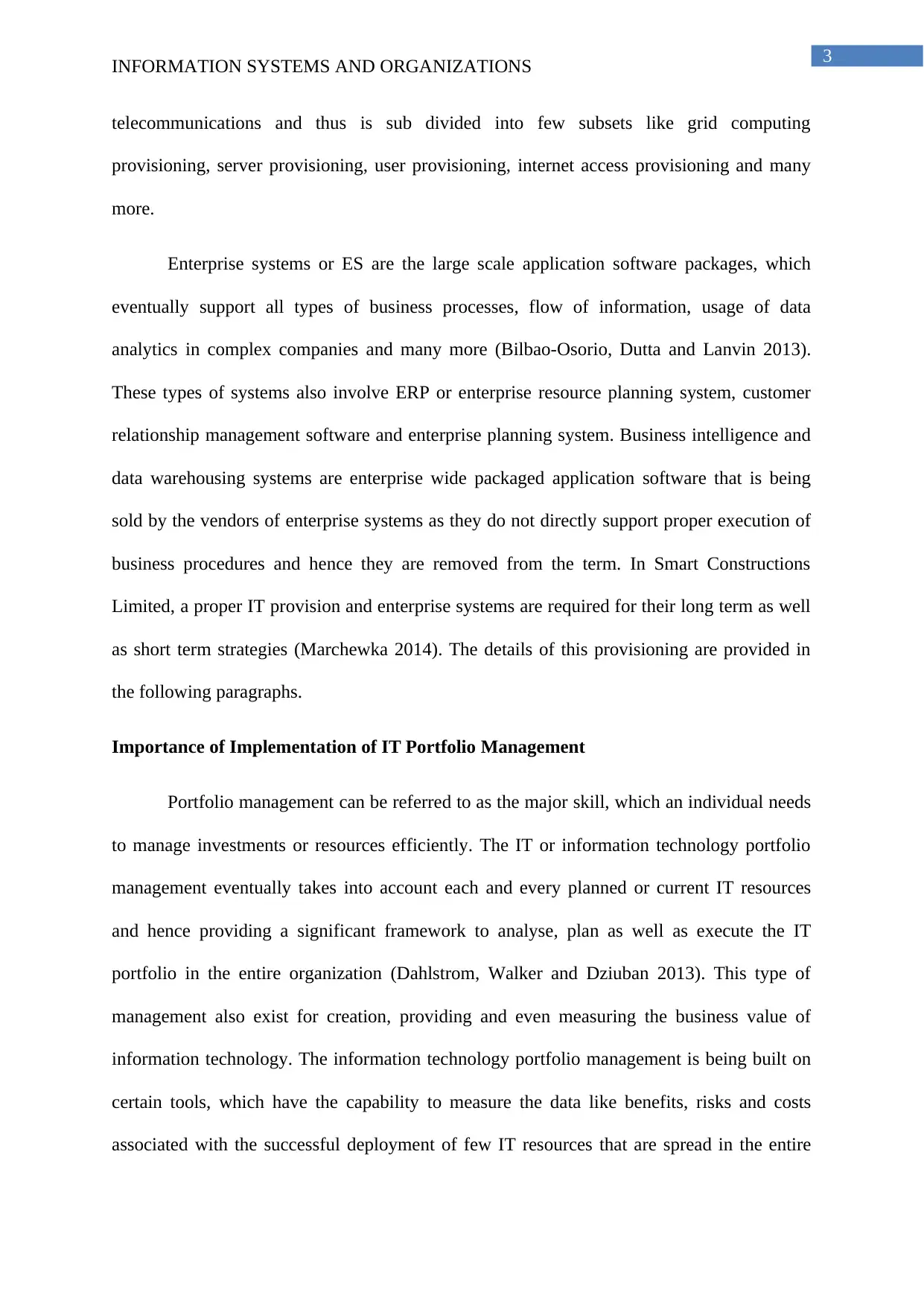
3
INFORMATION SYSTEMS AND ORGANIZATIONS
telecommunications and thus is sub divided into few subsets like grid computing
provisioning, server provisioning, user provisioning, internet access provisioning and many
more.
Enterprise systems or ES are the large scale application software packages, which
eventually support all types of business processes, flow of information, usage of data
analytics in complex companies and many more (Bilbao-Osorio, Dutta and Lanvin 2013).
These types of systems also involve ERP or enterprise resource planning system, customer
relationship management software and enterprise planning system. Business intelligence and
data warehousing systems are enterprise wide packaged application software that is being
sold by the vendors of enterprise systems as they do not directly support proper execution of
business procedures and hence they are removed from the term. In Smart Constructions
Limited, a proper IT provision and enterprise systems are required for their long term as well
as short term strategies (Marchewka 2014). The details of this provisioning are provided in
the following paragraphs.
Importance of Implementation of IT Portfolio Management
Portfolio management can be referred to as the major skill, which an individual needs
to manage investments or resources efficiently. The IT or information technology portfolio
management eventually takes into account each and every planned or current IT resources
and hence providing a significant framework to analyse, plan as well as execute the IT
portfolio in the entire organization (Dahlstrom, Walker and Dziuban 2013). This type of
management also exist for creation, providing and even measuring the business value of
information technology. The information technology portfolio management is being built on
certain tools, which have the capability to measure the data like benefits, risks and costs
associated with the successful deployment of few IT resources that are spread in the entire
INFORMATION SYSTEMS AND ORGANIZATIONS
telecommunications and thus is sub divided into few subsets like grid computing
provisioning, server provisioning, user provisioning, internet access provisioning and many
more.
Enterprise systems or ES are the large scale application software packages, which
eventually support all types of business processes, flow of information, usage of data
analytics in complex companies and many more (Bilbao-Osorio, Dutta and Lanvin 2013).
These types of systems also involve ERP or enterprise resource planning system, customer
relationship management software and enterprise planning system. Business intelligence and
data warehousing systems are enterprise wide packaged application software that is being
sold by the vendors of enterprise systems as they do not directly support proper execution of
business procedures and hence they are removed from the term. In Smart Constructions
Limited, a proper IT provision and enterprise systems are required for their long term as well
as short term strategies (Marchewka 2014). The details of this provisioning are provided in
the following paragraphs.
Importance of Implementation of IT Portfolio Management
Portfolio management can be referred to as the major skill, which an individual needs
to manage investments or resources efficiently. The IT or information technology portfolio
management eventually takes into account each and every planned or current IT resources
and hence providing a significant framework to analyse, plan as well as execute the IT
portfolio in the entire organization (Dahlstrom, Walker and Dziuban 2013). This type of
management also exist for creation, providing and even measuring the business value of
information technology. The information technology portfolio management is being built on
certain tools, which have the capability to measure the data like benefits, risks and costs
associated with the successful deployment of few IT resources that are spread in the entire
Paraphrase This Document
Need a fresh take? Get an instant paraphrase of this document with our AI Paraphraser
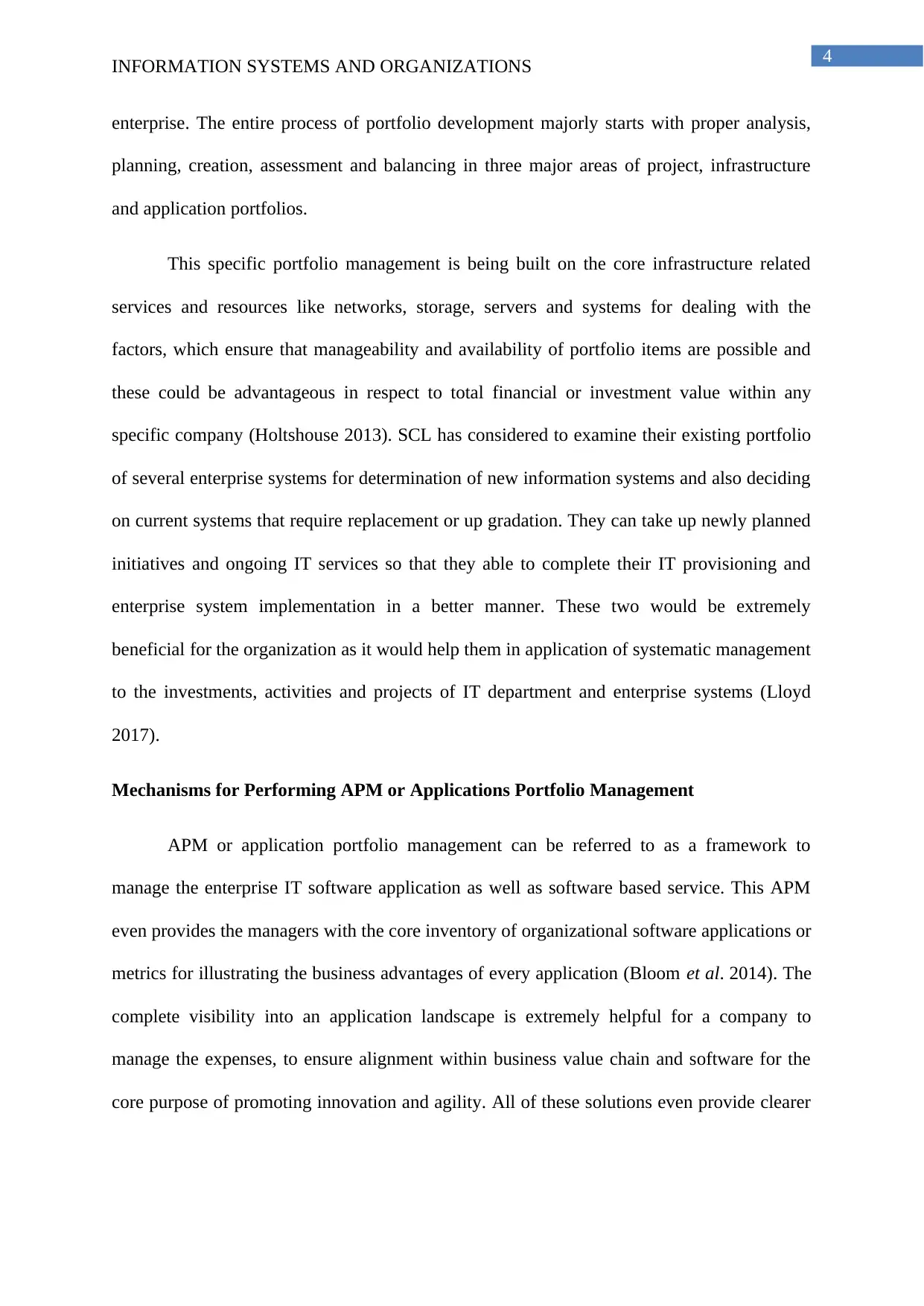
4
INFORMATION SYSTEMS AND ORGANIZATIONS
enterprise. The entire process of portfolio development majorly starts with proper analysis,
planning, creation, assessment and balancing in three major areas of project, infrastructure
and application portfolios.
This specific portfolio management is being built on the core infrastructure related
services and resources like networks, storage, servers and systems for dealing with the
factors, which ensure that manageability and availability of portfolio items are possible and
these could be advantageous in respect to total financial or investment value within any
specific company (Holtshouse 2013). SCL has considered to examine their existing portfolio
of several enterprise systems for determination of new information systems and also deciding
on current systems that require replacement or up gradation. They can take up newly planned
initiatives and ongoing IT services so that they able to complete their IT provisioning and
enterprise system implementation in a better manner. These two would be extremely
beneficial for the organization as it would help them in application of systematic management
to the investments, activities and projects of IT department and enterprise systems (Lloyd
2017).
Mechanisms for Performing APM or Applications Portfolio Management
APM or application portfolio management can be referred to as a framework to
manage the enterprise IT software application as well as software based service. This APM
even provides the managers with the core inventory of organizational software applications or
metrics for illustrating the business advantages of every application (Bloom et al. 2014). The
complete visibility into an application landscape is extremely helpful for a company to
manage the expenses, to ensure alignment within business value chain and software for the
core purpose of promoting innovation and agility. All of these solutions even provide clearer
INFORMATION SYSTEMS AND ORGANIZATIONS
enterprise. The entire process of portfolio development majorly starts with proper analysis,
planning, creation, assessment and balancing in three major areas of project, infrastructure
and application portfolios.
This specific portfolio management is being built on the core infrastructure related
services and resources like networks, storage, servers and systems for dealing with the
factors, which ensure that manageability and availability of portfolio items are possible and
these could be advantageous in respect to total financial or investment value within any
specific company (Holtshouse 2013). SCL has considered to examine their existing portfolio
of several enterprise systems for determination of new information systems and also deciding
on current systems that require replacement or up gradation. They can take up newly planned
initiatives and ongoing IT services so that they able to complete their IT provisioning and
enterprise system implementation in a better manner. These two would be extremely
beneficial for the organization as it would help them in application of systematic management
to the investments, activities and projects of IT department and enterprise systems (Lloyd
2017).
Mechanisms for Performing APM or Applications Portfolio Management
APM or application portfolio management can be referred to as a framework to
manage the enterprise IT software application as well as software based service. This APM
even provides the managers with the core inventory of organizational software applications or
metrics for illustrating the business advantages of every application (Bloom et al. 2014). The
complete visibility into an application landscape is extremely helpful for a company to
manage the expenses, to ensure alignment within business value chain and software for the
core purpose of promoting innovation and agility. All of these solutions even provide clearer
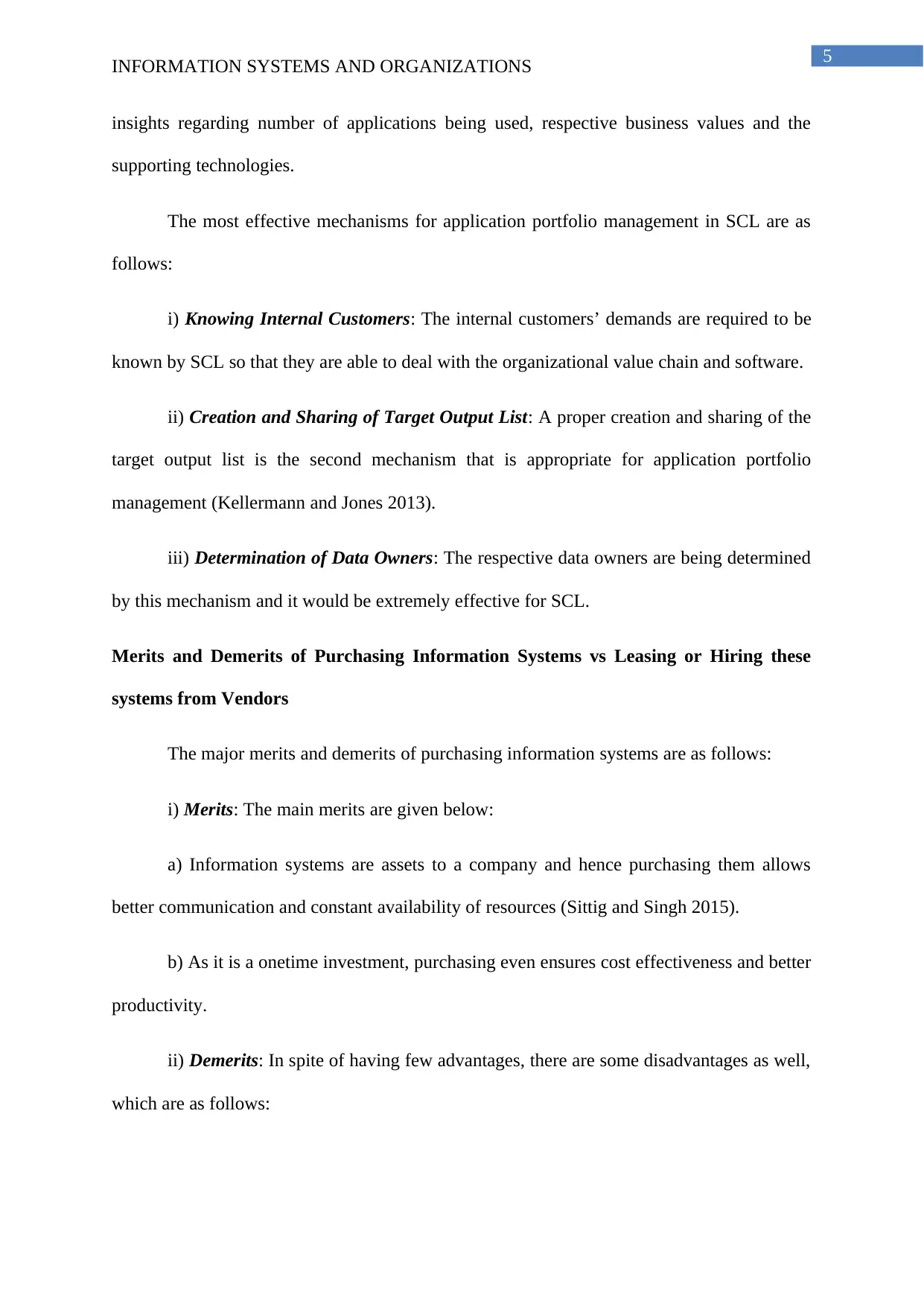
5
INFORMATION SYSTEMS AND ORGANIZATIONS
insights regarding number of applications being used, respective business values and the
supporting technologies.
The most effective mechanisms for application portfolio management in SCL are as
follows:
i) Knowing Internal Customers: The internal customers’ demands are required to be
known by SCL so that they are able to deal with the organizational value chain and software.
ii) Creation and Sharing of Target Output List: A proper creation and sharing of the
target output list is the second mechanism that is appropriate for application portfolio
management (Kellermann and Jones 2013).
iii) Determination of Data Owners: The respective data owners are being determined
by this mechanism and it would be extremely effective for SCL.
Merits and Demerits of Purchasing Information Systems vs Leasing or Hiring these
systems from Vendors
The major merits and demerits of purchasing information systems are as follows:
i) Merits: The main merits are given below:
a) Information systems are assets to a company and hence purchasing them allows
better communication and constant availability of resources (Sittig and Singh 2015).
b) As it is a onetime investment, purchasing even ensures cost effectiveness and better
productivity.
ii) Demerits: In spite of having few advantages, there are some disadvantages as well,
which are as follows:
INFORMATION SYSTEMS AND ORGANIZATIONS
insights regarding number of applications being used, respective business values and the
supporting technologies.
The most effective mechanisms for application portfolio management in SCL are as
follows:
i) Knowing Internal Customers: The internal customers’ demands are required to be
known by SCL so that they are able to deal with the organizational value chain and software.
ii) Creation and Sharing of Target Output List: A proper creation and sharing of the
target output list is the second mechanism that is appropriate for application portfolio
management (Kellermann and Jones 2013).
iii) Determination of Data Owners: The respective data owners are being determined
by this mechanism and it would be extremely effective for SCL.
Merits and Demerits of Purchasing Information Systems vs Leasing or Hiring these
systems from Vendors
The major merits and demerits of purchasing information systems are as follows:
i) Merits: The main merits are given below:
a) Information systems are assets to a company and hence purchasing them allows
better communication and constant availability of resources (Sittig and Singh 2015).
b) As it is a onetime investment, purchasing even ensures cost effectiveness and better
productivity.
ii) Demerits: In spite of having few advantages, there are some disadvantages as well,
which are as follows:
⊘ This is a preview!⊘
Do you want full access?
Subscribe today to unlock all pages.

Trusted by 1+ million students worldwide
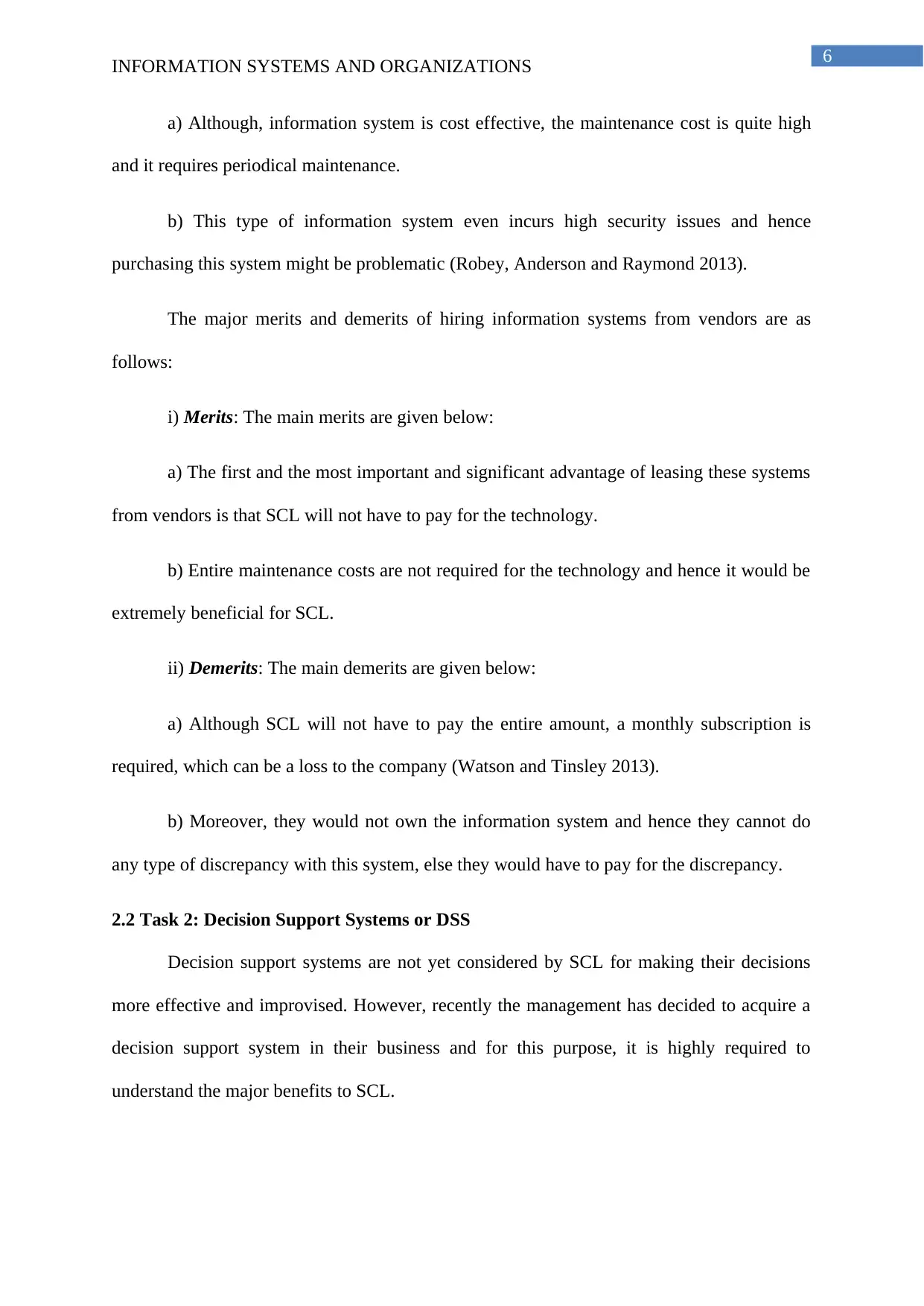
6
INFORMATION SYSTEMS AND ORGANIZATIONS
a) Although, information system is cost effective, the maintenance cost is quite high
and it requires periodical maintenance.
b) This type of information system even incurs high security issues and hence
purchasing this system might be problematic (Robey, Anderson and Raymond 2013).
The major merits and demerits of hiring information systems from vendors are as
follows:
i) Merits: The main merits are given below:
a) The first and the most important and significant advantage of leasing these systems
from vendors is that SCL will not have to pay for the technology.
b) Entire maintenance costs are not required for the technology and hence it would be
extremely beneficial for SCL.
ii) Demerits: The main demerits are given below:
a) Although SCL will not have to pay the entire amount, a monthly subscription is
required, which can be a loss to the company (Watson and Tinsley 2013).
b) Moreover, they would not own the information system and hence they cannot do
any type of discrepancy with this system, else they would have to pay for the discrepancy.
2.2 Task 2: Decision Support Systems or DSS
Decision support systems are not yet considered by SCL for making their decisions
more effective and improvised. However, recently the management has decided to acquire a
decision support system in their business and for this purpose, it is highly required to
understand the major benefits to SCL.
INFORMATION SYSTEMS AND ORGANIZATIONS
a) Although, information system is cost effective, the maintenance cost is quite high
and it requires periodical maintenance.
b) This type of information system even incurs high security issues and hence
purchasing this system might be problematic (Robey, Anderson and Raymond 2013).
The major merits and demerits of hiring information systems from vendors are as
follows:
i) Merits: The main merits are given below:
a) The first and the most important and significant advantage of leasing these systems
from vendors is that SCL will not have to pay for the technology.
b) Entire maintenance costs are not required for the technology and hence it would be
extremely beneficial for SCL.
ii) Demerits: The main demerits are given below:
a) Although SCL will not have to pay the entire amount, a monthly subscription is
required, which can be a loss to the company (Watson and Tinsley 2013).
b) Moreover, they would not own the information system and hence they cannot do
any type of discrepancy with this system, else they would have to pay for the discrepancy.
2.2 Task 2: Decision Support Systems or DSS
Decision support systems are not yet considered by SCL for making their decisions
more effective and improvised. However, recently the management has decided to acquire a
decision support system in their business and for this purpose, it is highly required to
understand the major benefits to SCL.
Paraphrase This Document
Need a fresh take? Get an instant paraphrase of this document with our AI Paraphraser
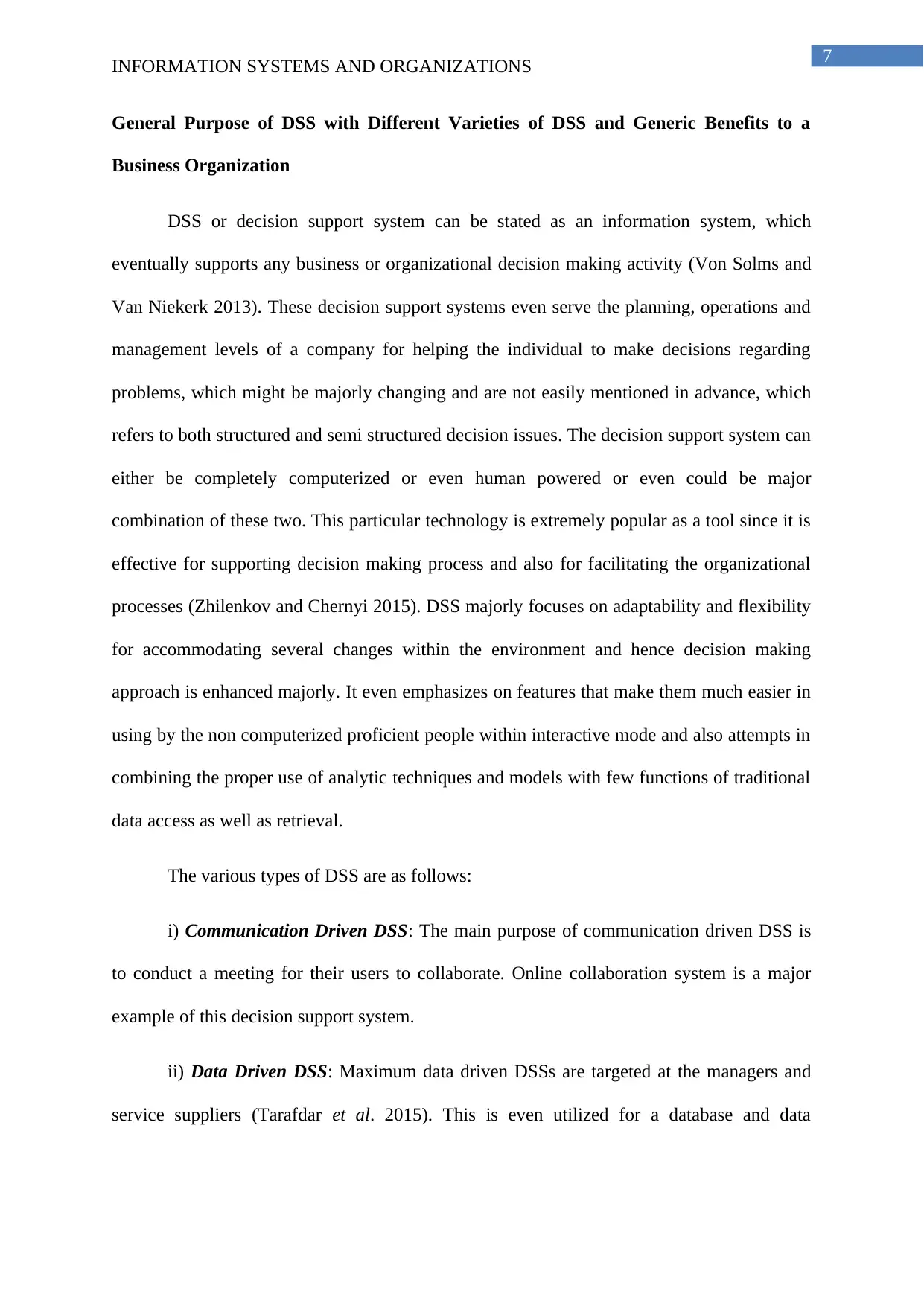
7
INFORMATION SYSTEMS AND ORGANIZATIONS
General Purpose of DSS with Different Varieties of DSS and Generic Benefits to a
Business Organization
DSS or decision support system can be stated as an information system, which
eventually supports any business or organizational decision making activity (Von Solms and
Van Niekerk 2013). These decision support systems even serve the planning, operations and
management levels of a company for helping the individual to make decisions regarding
problems, which might be majorly changing and are not easily mentioned in advance, which
refers to both structured and semi structured decision issues. The decision support system can
either be completely computerized or even human powered or even could be major
combination of these two. This particular technology is extremely popular as a tool since it is
effective for supporting decision making process and also for facilitating the organizational
processes (Zhilenkov and Chernyi 2015). DSS majorly focuses on adaptability and flexibility
for accommodating several changes within the environment and hence decision making
approach is enhanced majorly. It even emphasizes on features that make them much easier in
using by the non computerized proficient people within interactive mode and also attempts in
combining the proper use of analytic techniques and models with few functions of traditional
data access as well as retrieval.
The various types of DSS are as follows:
i) Communication Driven DSS: The main purpose of communication driven DSS is
to conduct a meeting for their users to collaborate. Online collaboration system is a major
example of this decision support system.
ii) Data Driven DSS: Maximum data driven DSSs are targeted at the managers and
service suppliers (Tarafdar et al. 2015). This is even utilized for a database and data
INFORMATION SYSTEMS AND ORGANIZATIONS
General Purpose of DSS with Different Varieties of DSS and Generic Benefits to a
Business Organization
DSS or decision support system can be stated as an information system, which
eventually supports any business or organizational decision making activity (Von Solms and
Van Niekerk 2013). These decision support systems even serve the planning, operations and
management levels of a company for helping the individual to make decisions regarding
problems, which might be majorly changing and are not easily mentioned in advance, which
refers to both structured and semi structured decision issues. The decision support system can
either be completely computerized or even human powered or even could be major
combination of these two. This particular technology is extremely popular as a tool since it is
effective for supporting decision making process and also for facilitating the organizational
processes (Zhilenkov and Chernyi 2015). DSS majorly focuses on adaptability and flexibility
for accommodating several changes within the environment and hence decision making
approach is enhanced majorly. It even emphasizes on features that make them much easier in
using by the non computerized proficient people within interactive mode and also attempts in
combining the proper use of analytic techniques and models with few functions of traditional
data access as well as retrieval.
The various types of DSS are as follows:
i) Communication Driven DSS: The main purpose of communication driven DSS is
to conduct a meeting for their users to collaborate. Online collaboration system is a major
example of this decision support system.
ii) Data Driven DSS: Maximum data driven DSSs are targeted at the managers and
service suppliers (Tarafdar et al. 2015). This is even utilized for a database and data
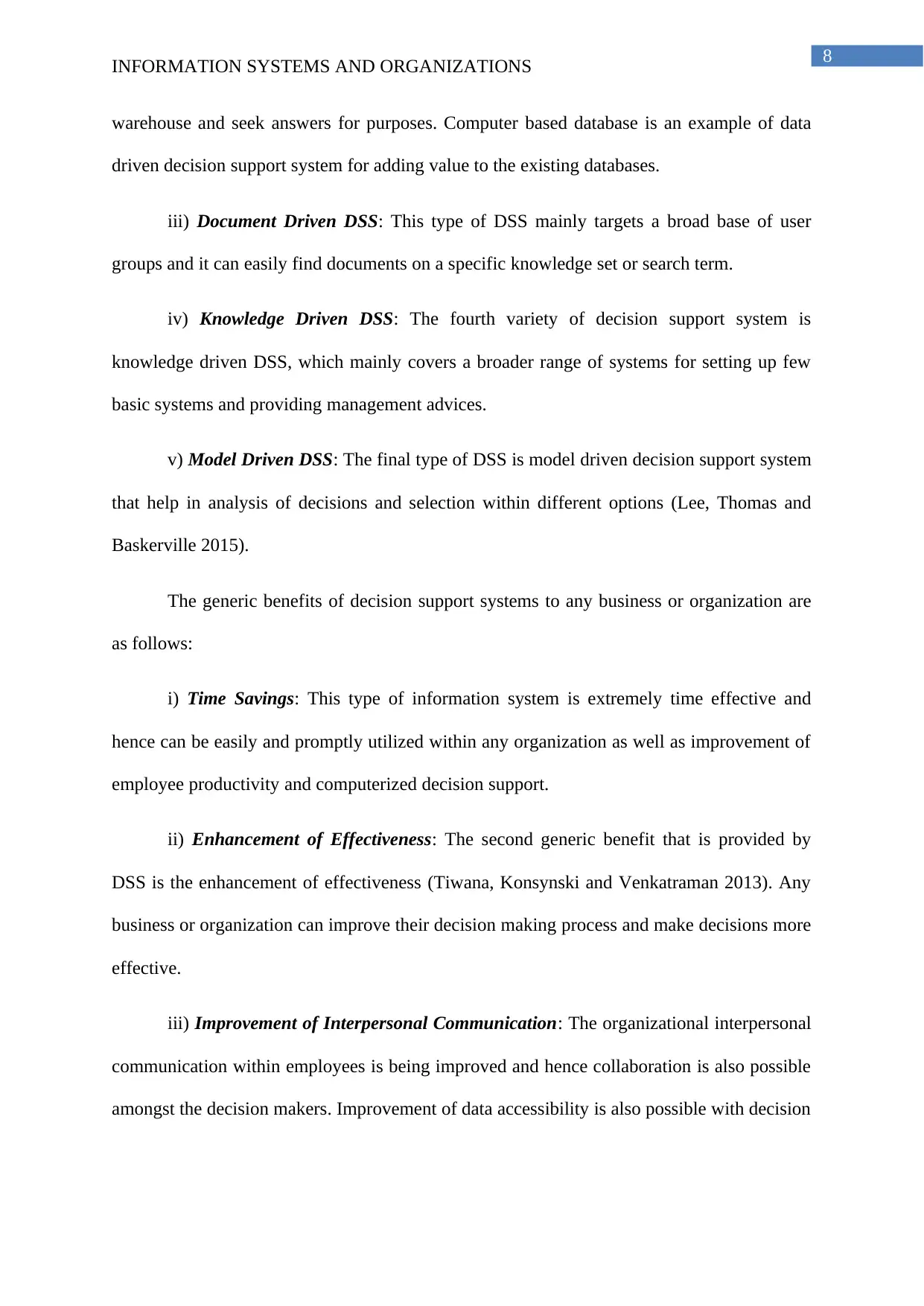
8
INFORMATION SYSTEMS AND ORGANIZATIONS
warehouse and seek answers for purposes. Computer based database is an example of data
driven decision support system for adding value to the existing databases.
iii) Document Driven DSS: This type of DSS mainly targets a broad base of user
groups and it can easily find documents on a specific knowledge set or search term.
iv) Knowledge Driven DSS: The fourth variety of decision support system is
knowledge driven DSS, which mainly covers a broader range of systems for setting up few
basic systems and providing management advices.
v) Model Driven DSS: The final type of DSS is model driven decision support system
that help in analysis of decisions and selection within different options (Lee, Thomas and
Baskerville 2015).
The generic benefits of decision support systems to any business or organization are
as follows:
i) Time Savings: This type of information system is extremely time effective and
hence can be easily and promptly utilized within any organization as well as improvement of
employee productivity and computerized decision support.
ii) Enhancement of Effectiveness: The second generic benefit that is provided by
DSS is the enhancement of effectiveness (Tiwana, Konsynski and Venkatraman 2013). Any
business or organization can improve their decision making process and make decisions more
effective.
iii) Improvement of Interpersonal Communication: The organizational interpersonal
communication within employees is being improved and hence collaboration is also possible
amongst the decision makers. Improvement of data accessibility is also possible with decision
INFORMATION SYSTEMS AND ORGANIZATIONS
warehouse and seek answers for purposes. Computer based database is an example of data
driven decision support system for adding value to the existing databases.
iii) Document Driven DSS: This type of DSS mainly targets a broad base of user
groups and it can easily find documents on a specific knowledge set or search term.
iv) Knowledge Driven DSS: The fourth variety of decision support system is
knowledge driven DSS, which mainly covers a broader range of systems for setting up few
basic systems and providing management advices.
v) Model Driven DSS: The final type of DSS is model driven decision support system
that help in analysis of decisions and selection within different options (Lee, Thomas and
Baskerville 2015).
The generic benefits of decision support systems to any business or organization are
as follows:
i) Time Savings: This type of information system is extremely time effective and
hence can be easily and promptly utilized within any organization as well as improvement of
employee productivity and computerized decision support.
ii) Enhancement of Effectiveness: The second generic benefit that is provided by
DSS is the enhancement of effectiveness (Tiwana, Konsynski and Venkatraman 2013). Any
business or organization can improve their decision making process and make decisions more
effective.
iii) Improvement of Interpersonal Communication: The organizational interpersonal
communication within employees is being improved and hence collaboration is also possible
amongst the decision makers. Improvement of data accessibility is also possible with decision
⊘ This is a preview!⊘
Do you want full access?
Subscribe today to unlock all pages.

Trusted by 1+ million students worldwide
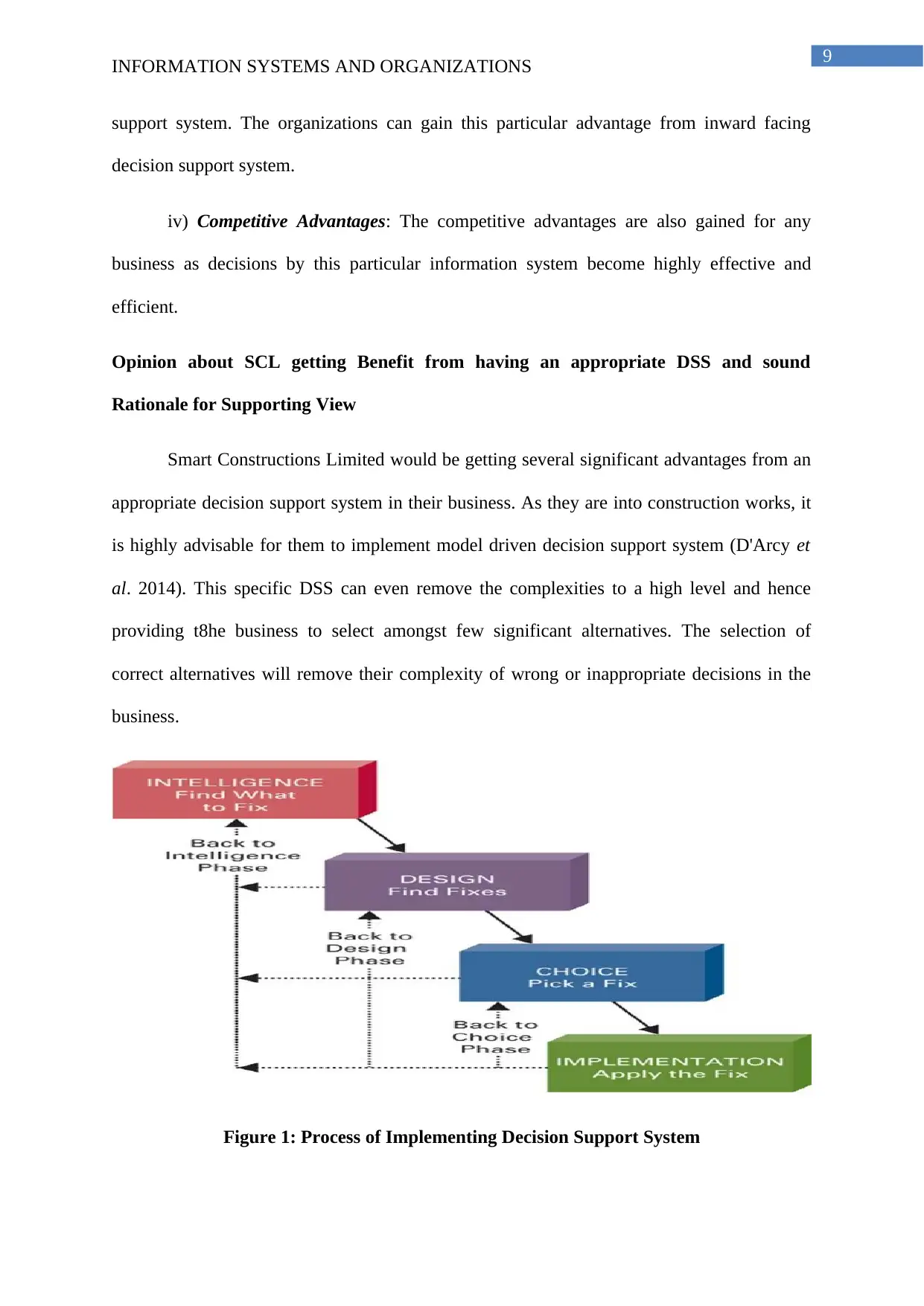
9
INFORMATION SYSTEMS AND ORGANIZATIONS
support system. The organizations can gain this particular advantage from inward facing
decision support system.
iv) Competitive Advantages: The competitive advantages are also gained for any
business as decisions by this particular information system become highly effective and
efficient.
Opinion about SCL getting Benefit from having an appropriate DSS and sound
Rationale for Supporting View
Smart Constructions Limited would be getting several significant advantages from an
appropriate decision support system in their business. As they are into construction works, it
is highly advisable for them to implement model driven decision support system (D'Arcy et
al. 2014). This specific DSS can even remove the complexities to a high level and hence
providing t8he business to select amongst few significant alternatives. The selection of
correct alternatives will remove their complexity of wrong or inappropriate decisions in the
business.
Figure 1: Process of Implementing Decision Support System
INFORMATION SYSTEMS AND ORGANIZATIONS
support system. The organizations can gain this particular advantage from inward facing
decision support system.
iv) Competitive Advantages: The competitive advantages are also gained for any
business as decisions by this particular information system become highly effective and
efficient.
Opinion about SCL getting Benefit from having an appropriate DSS and sound
Rationale for Supporting View
Smart Constructions Limited would be getting several significant advantages from an
appropriate decision support system in their business. As they are into construction works, it
is highly advisable for them to implement model driven decision support system (D'Arcy et
al. 2014). This specific DSS can even remove the complexities to a high level and hence
providing t8he business to select amongst few significant alternatives. The selection of
correct alternatives will remove their complexity of wrong or inappropriate decisions in the
business.
Figure 1: Process of Implementing Decision Support System
Paraphrase This Document
Need a fresh take? Get an instant paraphrase of this document with our AI Paraphraser
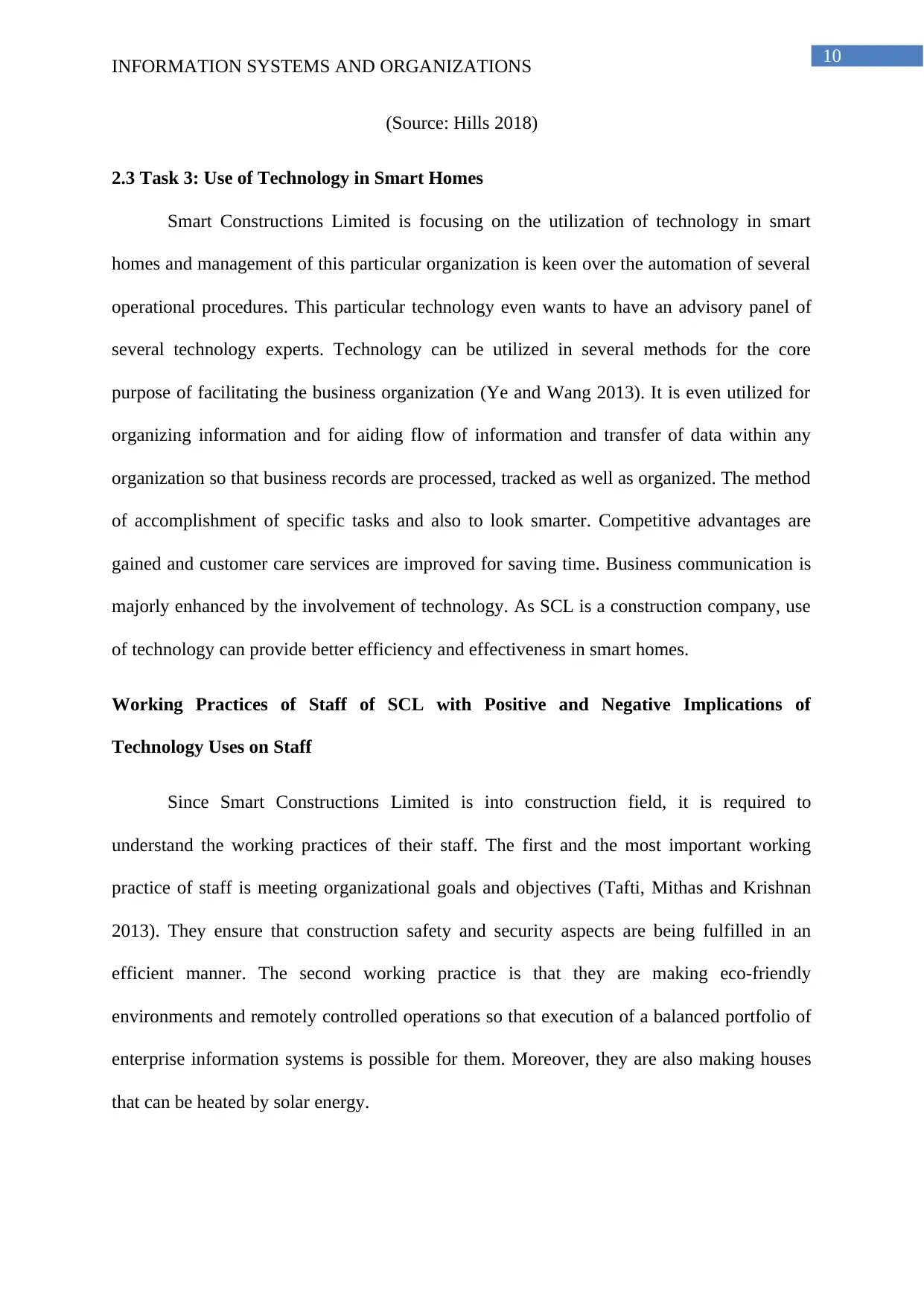
10
INFORMATION SYSTEMS AND ORGANIZATIONS
(Source: Hills 2018)
2.3 Task 3: Use of Technology in Smart Homes
Smart Constructions Limited is focusing on the utilization of technology in smart
homes and management of this particular organization is keen over the automation of several
operational procedures. This particular technology even wants to have an advisory panel of
several technology experts. Technology can be utilized in several methods for the core
purpose of facilitating the business organization (Ye and Wang 2013). It is even utilized for
organizing information and for aiding flow of information and transfer of data within any
organization so that business records are processed, tracked as well as organized. The method
of accomplishment of specific tasks and also to look smarter. Competitive advantages are
gained and customer care services are improved for saving time. Business communication is
majorly enhanced by the involvement of technology. As SCL is a construction company, use
of technology can provide better efficiency and effectiveness in smart homes.
Working Practices of Staff of SCL with Positive and Negative Implications of
Technology Uses on Staff
Since Smart Constructions Limited is into construction field, it is required to
understand the working practices of their staff. The first and the most important working
practice of staff is meeting organizational goals and objectives (Tafti, Mithas and Krishnan
2013). They ensure that construction safety and security aspects are being fulfilled in an
efficient manner. The second working practice is that they are making eco-friendly
environments and remotely controlled operations so that execution of a balanced portfolio of
enterprise information systems is possible for them. Moreover, they are also making houses
that can be heated by solar energy.
INFORMATION SYSTEMS AND ORGANIZATIONS
(Source: Hills 2018)
2.3 Task 3: Use of Technology in Smart Homes
Smart Constructions Limited is focusing on the utilization of technology in smart
homes and management of this particular organization is keen over the automation of several
operational procedures. This particular technology even wants to have an advisory panel of
several technology experts. Technology can be utilized in several methods for the core
purpose of facilitating the business organization (Ye and Wang 2013). It is even utilized for
organizing information and for aiding flow of information and transfer of data within any
organization so that business records are processed, tracked as well as organized. The method
of accomplishment of specific tasks and also to look smarter. Competitive advantages are
gained and customer care services are improved for saving time. Business communication is
majorly enhanced by the involvement of technology. As SCL is a construction company, use
of technology can provide better efficiency and effectiveness in smart homes.
Working Practices of Staff of SCL with Positive and Negative Implications of
Technology Uses on Staff
Since Smart Constructions Limited is into construction field, it is required to
understand the working practices of their staff. The first and the most important working
practice of staff is meeting organizational goals and objectives (Tafti, Mithas and Krishnan
2013). They ensure that construction safety and security aspects are being fulfilled in an
efficient manner. The second working practice is that they are making eco-friendly
environments and remotely controlled operations so that execution of a balanced portfolio of
enterprise information systems is possible for them. Moreover, they are also making houses
that can be heated by solar energy.
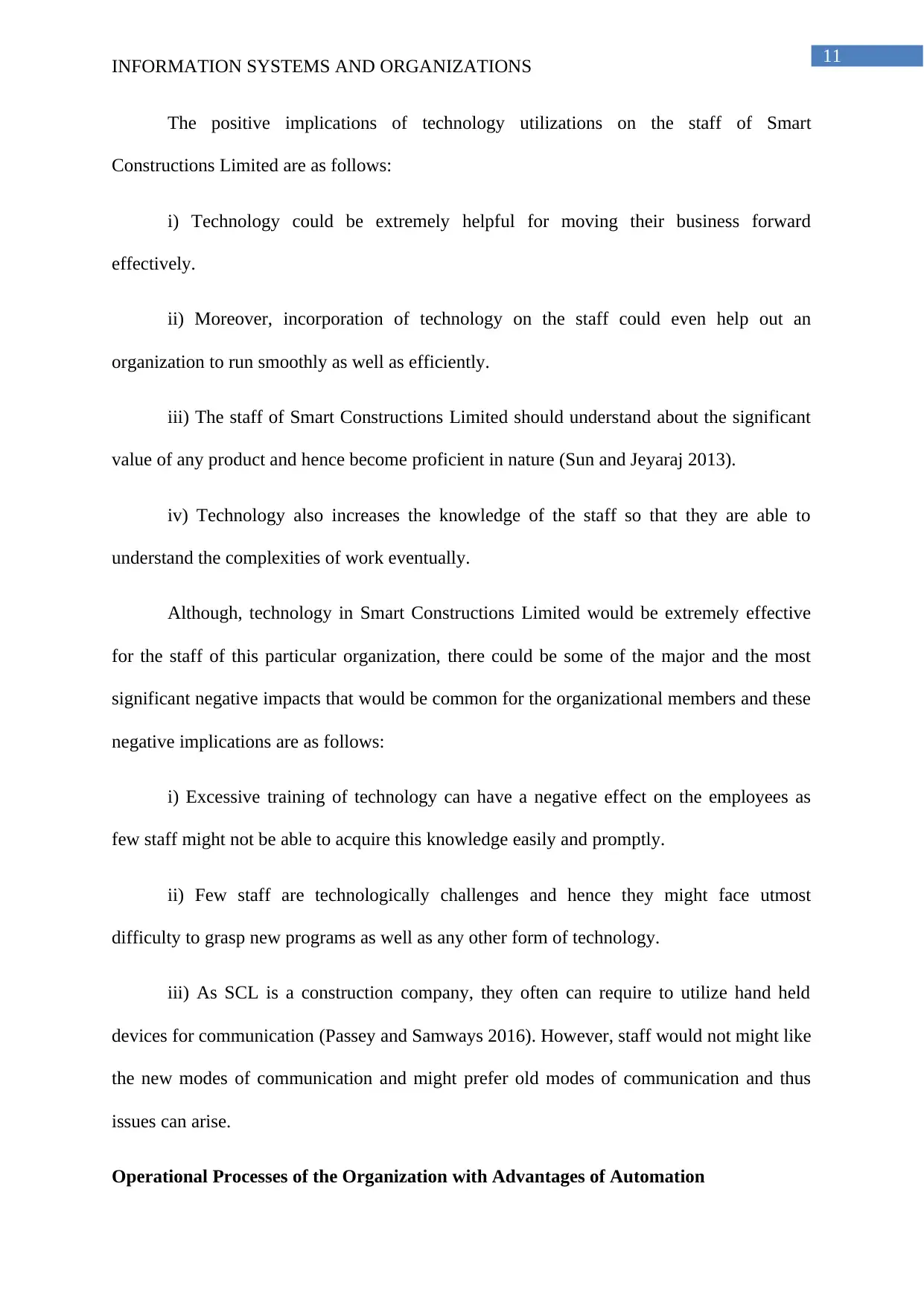
11
INFORMATION SYSTEMS AND ORGANIZATIONS
The positive implications of technology utilizations on the staff of Smart
Constructions Limited are as follows:
i) Technology could be extremely helpful for moving their business forward
effectively.
ii) Moreover, incorporation of technology on the staff could even help out an
organization to run smoothly as well as efficiently.
iii) The staff of Smart Constructions Limited should understand about the significant
value of any product and hence become proficient in nature (Sun and Jeyaraj 2013).
iv) Technology also increases the knowledge of the staff so that they are able to
understand the complexities of work eventually.
Although, technology in Smart Constructions Limited would be extremely effective
for the staff of this particular organization, there could be some of the major and the most
significant negative impacts that would be common for the organizational members and these
negative implications are as follows:
i) Excessive training of technology can have a negative effect on the employees as
few staff might not be able to acquire this knowledge easily and promptly.
ii) Few staff are technologically challenges and hence they might face utmost
difficulty to grasp new programs as well as any other form of technology.
iii) As SCL is a construction company, they often can require to utilize hand held
devices for communication (Passey and Samways 2016). However, staff would not might like
the new modes of communication and might prefer old modes of communication and thus
issues can arise.
Operational Processes of the Organization with Advantages of Automation
INFORMATION SYSTEMS AND ORGANIZATIONS
The positive implications of technology utilizations on the staff of Smart
Constructions Limited are as follows:
i) Technology could be extremely helpful for moving their business forward
effectively.
ii) Moreover, incorporation of technology on the staff could even help out an
organization to run smoothly as well as efficiently.
iii) The staff of Smart Constructions Limited should understand about the significant
value of any product and hence become proficient in nature (Sun and Jeyaraj 2013).
iv) Technology also increases the knowledge of the staff so that they are able to
understand the complexities of work eventually.
Although, technology in Smart Constructions Limited would be extremely effective
for the staff of this particular organization, there could be some of the major and the most
significant negative impacts that would be common for the organizational members and these
negative implications are as follows:
i) Excessive training of technology can have a negative effect on the employees as
few staff might not be able to acquire this knowledge easily and promptly.
ii) Few staff are technologically challenges and hence they might face utmost
difficulty to grasp new programs as well as any other form of technology.
iii) As SCL is a construction company, they often can require to utilize hand held
devices for communication (Passey and Samways 2016). However, staff would not might like
the new modes of communication and might prefer old modes of communication and thus
issues can arise.
Operational Processes of the Organization with Advantages of Automation
⊘ This is a preview!⊘
Do you want full access?
Subscribe today to unlock all pages.

Trusted by 1+ million students worldwide
1 out of 22
Related Documents
Your All-in-One AI-Powered Toolkit for Academic Success.
+13062052269
info@desklib.com
Available 24*7 on WhatsApp / Email
![[object Object]](/_next/static/media/star-bottom.7253800d.svg)
Unlock your academic potential
Copyright © 2020–2025 A2Z Services. All Rights Reserved. Developed and managed by ZUCOL.





